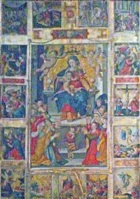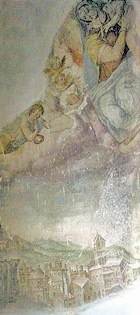

Litardo Piccioli, who was born in Amelia, trained under Livio Agresti. He was working with Agresti in 1575 in the Cappella della Trinità of the church of Santo Spirito in Sassia, Rome, when the failing Agresti named him as a beneficiary of his will, bequeathing to him “his paints and other things”.
No documented works by Litardo Piccioli are known. However, a number of works in Amelia and in the surrounding area are attributed to him.
Amelia
Madonna of the Rosary (16th century)

Virgin protecting Amelia (16th century)

Crucifixion with the Virgin and St Jerome (16th century)
This altarpiece in San Girolamo, which is set against a cityscape of Amelia, is attributed to Litardo Piccioli.
Altarpieces (1602)
These two altarpieces, which are attributed to Litardo Piccioli, are on the entrance wall of the ex-church of San Giovanni Decollato (previously di Santa Maria dei Laici, della Misericordia or dell’ Ospedaletto). They depict:
-
✴the Baptism of Christ; and
-
✴St John the Baptist preaching (dated by inscription).
Frescoes of Palazzo Petrignani (begun in 1572)
The frescoes of Palazzo Petrignani are difficult to attribute because almost all of them derive from engravings of well-known works in Rome. They are sometimes attributed to the Zuccari brothers because some of them are based on engravings of works by these artists. It is more likely that they were the work (at least in part) of Livio Agresti (see above), who was documented in Amelia at this time. Litardo Piccioli may have assisted him, and could well have continued the work after Agresti left Amelia.
Frescoes in Palazzo Venturelli (16th century)




